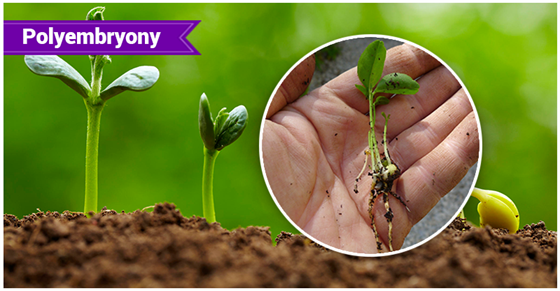
This is a natural phenomenon, quite common in both dicotyledons and monocotyledons.
What is Polyembryony?
As per the name Polyembryony – it refers to the development of many embryos.
When two or more than two embryos develop from a single fertilized egg, then this phenomenon is known as Polyembryony. In the case of humans, it results in forming two identical twins. This phenomenon is found both in plants and animals.
The best example of Polyembryony in the animal kingdom is the nine-banded armadillo. It is a medium-sized mammal found in certain parts of America and this wild species gives birth to identical quadruplets.
Also Read Reproduction in Animals.
Let us learn more about the Polyembryony in plants, types and its importance.
Polyembryony in Plants
The production of two or more than two embryos from a single seed or fertilized egg is termed as Polyembryony. In plants, this phenomenon is caused either due to the fertilization of one or more than one embryonic sac or due to the origination of embryos outside of the embryonic sac.
This natural phenomenon was first discovered in the year 1719 by Antonie van Leeuwenhoek in Citrus plant seeds.
Also read: Fruit and Seed Formation Without Fertilization
Types of Polyembryony
There are two different types of polyembryony:
- Induced Polyembryony – experimentally induced
- Spontaneous Polyembryony – naturally occurring
According to Webber, polyembryony is classified into three different types :
- Cleavage Polyembryony:
- In the case of this type, a single fertilized egg gives rise to a number of embryos.
- Simple polyembryony: In this type, a number of embryos develop as a result of the fertilization of several archegonia.
- Rosette polyembryony: Additional embryos develop from the rosette cells in certain gymnosperms, this type of polyembryony is termed rosette polyembryony.
Explore more: Sexual Reproduction In Plants
Polyembryony in Different Groups of Gymnosperms
- Polyembryony in Cycadales
In Cycadales, polyembryony is not a usual phenomenon. But in 1964, Rao reported the occurrence of simple polyembryony in Cycas Circinalis. In this species, two adjacent archegonia of the same ovule sometimes grow independently into two embryos and also rarely into two seedlings.
- Polyembryony in Coniferales
In Case of Coniferales, simple polyembryony occurs in the majority of its members and here the number of embryos varies from 2 to many. It has been reported that cleavage polyembryony occurs in several groups of Pinaceae, Taxodiaceae, Cupressaceae, and Podocarpaceae. In Cupressus, both simple and cleavage polyembryony are common.
- Polyembryony in Taxales
Various archegonia are present in the female gametophyte of Taxus. Simple polyembryony occurs due to the fertilization of many of the archegonia eggs. But, out of many, only a single embryo attains maturity. Cleavage of suspensor cells occurs. The suspensors separate from each other, and each of them may carry one or more embryonal units. Sometimes, groups of meristematic cells are observed at the base of the suspensor cells These groups of cells are called the rosette embryos. Further development, however, does not take place in these embryos.
- Polyembryony in Gnetales
All Gnetales exhibit polyembryony. Polyembryony is found to be of very high order in Gnetum. In this group, there are not only several prothalli and zygotes in each seed, but there is a multiplication of embryos from each zygote by the branching of the primary suspensors.
Learn more about Polyembryony, its types, process, significance and other related topics @ BYJU’S Biology

such a fruitful information thanks.
such a brainly information
THANK YOU!
Thank you so much😊. Its really helpfull .